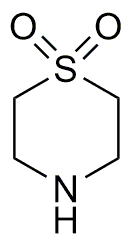Thiomorpholine 1,1-dioxide is widely utilized in research focused on:
- Pharmaceutical Development: This compound serves as a key intermediate in the synthesis of various pharmaceuticals, particularly in the development of anti-inflammatory and analgesic drugs. Its unique structure allows for modifications that enhance drug efficacy.
- Agricultural Chemicals: It is employed in the formulation of pesticides and herbicides, providing effective solutions for crop protection. Its ability to enhance the bioavailability of active ingredients makes it valuable in agricultural applications.
- Material Science: Thiomorpholine 1,1-dioxide is used in the creation of polymers and resins, contributing to materials with improved durability and resistance to environmental factors. This application is particularly beneficial in the production of coatings and adhesives.
- Analytical Chemistry: The compound is utilized as a reagent in various analytical techniques, including chromatography and spectroscopy. Its role in enhancing detection limits and improving accuracy is crucial for researchers in quality control and environmental monitoring.
- Biochemical Research: It acts as a stabilizing agent in biochemical assays, facilitating the study of enzyme kinetics and protein interactions. This application is essential for researchers exploring metabolic pathways and drug interactions.
General Information
Properties
Safety and Regulations
Applications
Thiomorpholine 1,1-dioxide is widely utilized in research focused on:
- Pharmaceutical Development: This compound serves as a key intermediate in the synthesis of various pharmaceuticals, particularly in the development of anti-inflammatory and analgesic drugs. Its unique structure allows for modifications that enhance drug efficacy.
- Agricultural Chemicals: It is employed in the formulation of pesticides and herbicides, providing effective solutions for crop protection. Its ability to enhance the bioavailability of active ingredients makes it valuable in agricultural applications.
- Material Science: Thiomorpholine 1,1-dioxide is used in the creation of polymers and resins, contributing to materials with improved durability and resistance to environmental factors. This application is particularly beneficial in the production of coatings and adhesives.
- Analytical Chemistry: The compound is utilized as a reagent in various analytical techniques, including chromatography and spectroscopy. Its role in enhancing detection limits and improving accuracy is crucial for researchers in quality control and environmental monitoring.
- Biochemical Research: It acts as a stabilizing agent in biochemical assays, facilitating the study of enzyme kinetics and protein interactions. This application is essential for researchers exploring metabolic pathways and drug interactions.
Documents
Safety Data Sheets (SDS)
The SDS provides comprehensive safety information on handling, storage, and disposal of the product.
Product Specification (PS)
The PS provides a comprehensive breakdown of the product’s properties, including chemical composition, physical state, purity, and storage requirements. It also details acceptable quality ranges and the product's intended applications.
Certificates of Analysis (COA)
Search for Certificates of Analysis (COA) by entering the products Lot Number. Lot and Batch Numbers can be found on a product’s label following the words ‘Lot’ or ‘Batch’.
*Catalog Number
*Lot Number
Certificates Of Origin (COO)
This COO confirms the country where the product was manufactured, and also details the materials and components used in it and whether it is derived from natural, synthetic, or other specific sources. This certificate may be required for customs, trade, and regulatory compliance.
*Catalog Number
*Lot Number
Safety Data Sheets (SDS)
The SDS provides comprehensive safety information on handling, storage, and disposal of the product.
DownloadProduct Specification (PS)
The PS provides a comprehensive breakdown of the product’s properties, including chemical composition, physical state, purity, and storage requirements. It also details acceptable quality ranges and the product's intended applications.
DownloadCertificates of Analysis (COA)
Search for Certificates of Analysis (COA) by entering the products Lot Number. Lot and Batch Numbers can be found on a product’s label following the words ‘Lot’ or ‘Batch’.
*Catalog Number
*Lot Number
Certificates Of Origin (COO)
This COO confirms the country where the product was manufactured, and also details the materials and components used in it and whether it is derived from natural, synthetic, or other specific sources. This certificate may be required for customs, trade, and regulatory compliance.


